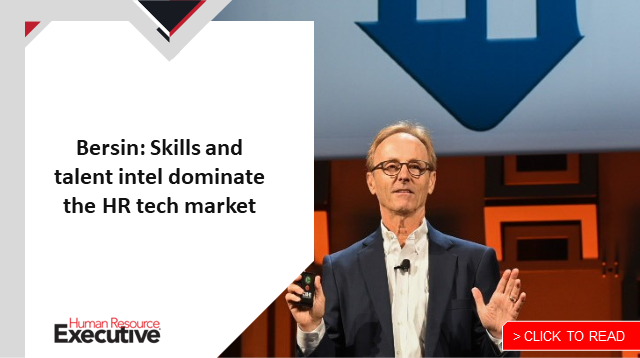In my last column, I laid out the sometimes-daunting steps to take and obstacles to overcome in implementing a new workplace technology platform. While the promise of these technologies is great, the reality is that we must be eyes wide open about what it takes to actually implement and leverage their potential—which often has little to do with IT and is mostly about people.
In this column, I’ll walk you through what happens after you get that “wet ink” signature on a vendor agreement.
Part 1: How to buy HR tech: Getting started with a strategy
Part 3: What you need to know about sustaining your new HR tech
The work starts now
It is easy to be pretty beat down after jumping through countless hoops to align fellow stakeholders around your buying decision and push a new vendor and agreement through the messy red tape internally.
This is the part where I see a majority of HR leaders making a huge mistake that can cheat them out of fulfilling the original intent of their purchase. Simply “flipping the switch” and turning on a new tech platform doesn’t work. A recent McKinsey Global Survey found that 35% of financial benefit is lost in the implementation phase of adopting new technology—the greatest percentage of all phases of a digital transformation. Therefore, the only way these systems become an embedded part of the way work gets done is through a thoughtful and sustained change-management approach paired with strong champion ownership. In fact, the Big 4 accounting firms know this well, as systems implementation is now a material part of their billable business.
Identify your champions
 Define the governance of the platform, tapping into business leaders who want to make their mark or who have high credibility. Agree on how often you’ll meet, the goal of the group and each person’s part to play. Behind every great system, implementation is a small team of leaders committed to ongoing refinement and reinforcement.
Define the governance of the platform, tapping into business leaders who want to make their mark or who have high credibility. Agree on how often you’ll meet, the goal of the group and each person’s part to play. Behind every great system, implementation is a small team of leaders committed to ongoing refinement and reinforcement.
Start with the end in mind
While it can be tempting to get into the hyper-tactical elements of system configuration, user access and other interface choices, HR leaders need to pull up before they begin to engage in these sorts of details.
It is all about asking yourself and your colleagues the right set of questions. What were the original intent and objectives of buying this technology? What sort of impact or proof are we wanting to see, and over what period of time? The answers to these questions must be focused, concise and crisp (think Tweet-length). You’ll want to be “on message” with these as you communicate with various stakeholder groups, lest your new platform gain a reputation as a dud with expectations of a panacea that can solve far more problems than it was ever intended to.
Define success
Peter Drucker, the management expert, often asked executive teams the question “How will you know?” in regard to the fulfillment of their business strategies. This is a critical game theory exercise to define how you’ll keep score and what the targeted levels of performance should be. No different than defining OKRs, KPIs or MBOs (the alphabet soup of HR!), the hardest part is the definition.
Leverage your vendor partners to get their advice; in particular, look to the metrics and even qualitative information that will be collected in dashboards or reports. It is crucial to use measures that are benchmarked with other customers or other studies/research in order to inform what “good” looks like. Nothing brings more credibility to internal performance numbers than external benchmarks.
As you start to roll out your platform, you’ll want to constantly repeat the key objectives and definitions of measurable success as you get started. Much like any competitive sport, the rule of the game—including objectives and scoring—should be clear before the clock starts running.
Manage expectations
We need to balance our zeal for our shiny new platform with the practical reality that anything new is not going to go perfectly, we’ll learn things along the way and it will trigger the worst in humans as they deal with change.
This is where phased rollouts can be really helpful, starting with a particular line of business, department or geography (ideally, one that’s more likely to embrace the technology and provide useful feedback).
Forbes Human Resources Council expert Mofoluwaso Ilevbare (Primary Connect) notes that “word of mouth travels faster, so having a pilot session that trains change champions across teams ahead of deployment to be ready to drive the integration across the organization is impactful. This should include leaders’ role modeling as well.”
Quickly iterating on how phased rollouts go will help end users shape the adoption and reduce multiplying mistakes. And letting executives know in advance that they should anticipate some things not going as planned—and that you have a team on-hand to quickly adapt and resolve feedback—will help them avoid feeling surprised or worrying that their internal reputations will be sullied if there are any hiccups.
 And be ready for some crabapples in your organization, who may surprisingly be the ones who complained the loudest about prior systems or the need for an upgrade. Simply put, change management often has four stages: ignorance, anger/rejection, reluctant acceptance and appreciation. Even when you buy the best platform in the market, your managers and employees will all go through these phases—so don’t flinch when you get some pushback or conflict; people are just being … people.
And be ready for some crabapples in your organization, who may surprisingly be the ones who complained the loudest about prior systems or the need for an upgrade. Simply put, change management often has four stages: ignorance, anger/rejection, reluctant acceptance and appreciation. Even when you buy the best platform in the market, your managers and employees will all go through these phases—so don’t flinch when you get some pushback or conflict; people are just being … people.
Roll it out with flair
Throughout most of my career, HR programs have never gotten much marketing pizazz or sparkle. This is a huge issue for the function, as the expectations of our talent have never been higher, given the incredible innovation they’ve enjoyed in their consumer experiences.
There are lots of ways to make a rollout fun, including giving the platform an internal pet name, showcasing power users, doing contests, throwing parties, giving away SWAG to early adopters and even inviting employees into advisory groups. Tapping into your marketing and communications teams for their ideas, resources and creativity can be a real win-win. And be sure to ask vendors to connect you with some of their most successful customers using the platforms as well, so that you can engage in some idea-sharing with other HR leaders.
Remove barriers
My fundamental belief is that if you hire good people who are aligned with your mission and strategy, then they’ll want to do the right thing. And when you see that their behaviors (say, in the form of system adoption) aren’t what you want, the first thing you should ask is, “Is something getting in their way?”
 As a management consultant, I learned that when it came to workplace safety, a best practice was “to make the safe thing to do the easiest thing to do.” That’s always stuck with me, and I’ve found that systems implementation works similarly—best behaviors, including usage and outcomes, are possible with the least amount of friction. So get to fixing bugs, doing more just-in-time training, implementing Single Sign On, reconfiguring the interfaces, improving the data or doing whatever else it takes to make it easy to use. Again, make sure to leverage advice and best practices from your vendors.
As a management consultant, I learned that when it came to workplace safety, a best practice was “to make the safe thing to do the easiest thing to do.” That’s always stuck with me, and I’ve found that systems implementation works similarly—best behaviors, including usage and outcomes, are possible with the least amount of friction. So get to fixing bugs, doing more just-in-time training, implementing Single Sign On, reconfiguring the interfaces, improving the data or doing whatever else it takes to make it easy to use. Again, make sure to leverage advice and best practices from your vendors.
Think sustainment
It is easy to goose usage data in the first few days or weeks of a rollout, but plan for the eventual dip in adoption that can come after the sizzle of something new wears off. Much like the space shuttle, the rocket that gets it off the ground must be supplemented with a second-stage booster to propel it further. Refreshing the teams behind the platforms through talent rotations can be a way to help keep the energy alive.
*My next column will focus on the work that needs to happen after an HR tech platform has been rolled out. This work is critical to protecting what you’ve built, using learnings to inform other initiatives, and ensuring that it can be packaged as part of your career narrative.



